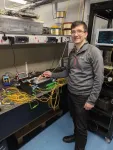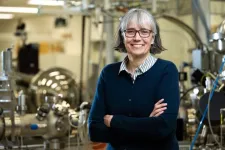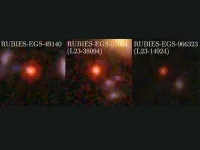(Press-News.org) Osteoporosis is so difficult to detect in early stage it’s called the “silent disease.” What if artificial intelligence could help predict a patient’s chances of having the bone-loss disease before ever stepping into a doctor’s office?
Tulane University researchers made progress toward that vision by developing a new deep learning algorithm that outperformed existing computer-based osteoporosis risk prediction methods, potentially leading to earlier diagnoses and better outcomes for patients with osteoporosis risk.
Their results were recently published in Frontiers in Artificial Intelligence.
Deep learning models have gained notice for their ability to mimic human neural networks and find trends within large datasets without being specifically programmed to do so. Researchers tested the deep neural network (DNN) model against four conventional machine learning algorithms and a traditional regression model, using data from over 8,000 participants aged 40 and older in the Louisiana Osteoporosis Study. The DNN achieved the best overall predictive performance, measured by scoring each model’s ability to identify true positives and avoid mistakes.
“The earlier osteoporosis risk is detected, the more time a patient has for preventative measures,” said lead author Chuan Qiu, a research assistant professor at the Tulane School of Medicine Center for Biomedical Informatics and Genomics. “We were pleased to see our DNN model outperform other models in accurately predicting the risk of osteoporosis in an aging population.”
In testing the algorithms using a large sample size of real-world health data, the researchers were also able to identify the 10 most important factors for predicting osteoporosis risk: weight, age, gender, grip strength, height, beer drinking, diastolic pressure, alcohol drinking, years of smoking, and income level.
Notably, the simplified DNN model using these top 10 risk factors performed nearly as well as the full model which included all risk factors.
While Qiu admitted that there is much more work to be done before an AI platform can be used by the public to predict an individual’s risk of osteoporosis, he said identifying the benefits of the deep learning model was a step in that direction.
“Our final aim is to allow people to enter their information and receive highly accurate osteoporosis risk scores to empower them to seek treatment to strengthen their bones and reduce any further damage,” Qiu said.
END
Can A.I. tell you if you have osteoporosis? Newly developed deep learning model shows promise
2024-06-28
ELSE PRESS RELEASES FROM THIS DATE:
Work-related nerve injuries are common with repetitive motions
2024-06-28
Although you may not always realize it, many of the jobs you do can put strain on, and even cause damage to, your nerves.
Sandra Hearn, M.D., the associate chair of Education and Professional Development in the Department of Physical Medicine and Rehabilitation, and a team of collaborators, set out to better understand the causes of occupational nerve injuries.
What is an occupational nerve injury?
An occupational nerve injury refers to a problem with your peripheral nerves that's caused by a work-related activity. It's often seen ...
Mount Sinai study reveals significant differences in RNA editing between postmortem and living human brain
2024-06-28
Researchers from the Icahn School of Medicine at Mount Sinai have shed valuable light on the nuanced functions and intricate regulatory methods of RNA editing, a critical mechanism underlying brain development and disease.
In a study published June 26 in Nature Communications, the team reported finding major differences between postmortem and living prefrontal cortex brain tissues as they relate to one of the most abundant RNA modifications in the brain, known as adenosine-to-inosine (A-to-I) editing. This discovery will play a significant role ...
Penn researchers will investigate link between TBI and dementia with $10M NIH grant
2024-06-28
PHILADELPHIA— A team of researchers led by Penn Medicine will investigate the link between traumatic brain injuries (TBI) and Alzheimer’s disease and related dementias (ADRD) over the next five years with a $10 million grant from the National Institute of Neurological Disorders and Stroke (NINDS). Using an extensive tissue bank including over 1,000 samples, the researchers aim to uncover the underlying biological mechanisms of TBI-related neurodegeneration (TReND) from a variety of brain injury types. ...
Aston University researchers break ‘world record’ again for data transmission speed
2024-06-28
Aston Institute of Photonic Research academics are part of a team that sent data at a rate of 402 terabits per second
This beats their previous record of 301 terabits per second
They constructed the first optical transmission system covering six wavelength bands.
Aston University researchers are part of a team that has sent data at a record rate of 402 terabits per second using commercially available optical fibre.
This beats their previous record, announced in March 2024, of 301 terabits or 301,000,000 megabits per second using a single, standard optical fibre.
"If compared to the internet connection speed recommendations of Netflix, of 3 Mbit/s ...
A few surgical procedures account for high number of opioid prescriptions
2024-06-28
A handful of common surgical procedures account for large shares of all opioids dispensed after surgery in children and adults, according to two studies recently published by researchers at the University of Michigan.
The studies, published this week in Pediatrics and JAMA Network Open, report that the top three procedures for children ages 0-11 account for 59% of opioids dispensed after surgery (tonsillectomies and adenoidectomies 50%, upper extremity fractures 5% and removal of deep implants 4%). Among those ages 12-21, the top three procedures account for ...
Clemson University bioengineer receives $2.1 million SBIR grant to develop long-lasting natural disinfectants superior to currently available disinfectants
2024-06-28
Alexey Vertegel, Ph.D., Associate Professor in the Department of Bioengineering, Clemson University, has been awarded a $2.1M Small Business Innovation Research (SBIR) Phase II grant from the National Institute of Allergy and Infectious Diseases (NIAID) to develop long-lasting natural disinfectants. Currently used surface disinfectants provide high-level activity over a relatively short period of time, typically less than 4 hours. During the Phase I study, his team developed a novel film-forming disinfectant based on chitosan, alcohol, and a natural antimicrobial, which is slowly released from the ...
Elke Arenholz named director of the National Synchrotron Light Source II at Brookhaven Lab
2024-06-28
UPTON, N.Y. — Elke Arenholz, a renowned scientist known for her expertise in magnetic materials and X-ray spectroscopy, scattering, imaging, and instrument development, has been named director of the National Synchrotron Light Source II (NSLS-II), a U.S. Department of Energy (DOE) Office of Science user facility at DOE’s Brookhaven National Laboratory, effective August 2024.
Arenholz’s appointment comes following a search that began in summer 2023 after John Hill, the previous director of NSLS-II, ...
Tiny bright objects discovered at dawn of universe baffle scientists
2024-06-28
UNIVERSITY PARK, Pa. — A recent discovery by NASA’s James Webb Space Telescope (JWST) confirmed that luminous, very red objects previously detected in the early universe upend conventional thinking about the origins and evolution of galaxies and their supermassive black holes.
An international team, led by Penn State researchers, using the NIRSpec instrument aboard JWST as part of the RUBIES survey identified three mysterious objects in the early universe, about 600-800 million years after the Big Bang, ...
Study shows corporate social misbehavior hurts brands
2024-06-28
In today's interconnected world, the actions of corporations can have far-reaching consequences. A new study, co-authored by two University of Akron (UA) faculty and published in the top ranked international business journal Global Strategy Journal, reveals that incident of corporate social irresponsibility (CSI) — like pollution, corruption, discrimination, or poor labor conditions in supply chains — significantly damage brand reputation and international sales growth.
Over nine years and across 109 countries, researchers tracked the performance of 335 company branches alongside reported CSI incidents involving their parent companies. The results clearly ...
Creating supranormal hearing in mice
2024-06-28
A study from Michigan Medicine's Kresge Hearing Research Institute was able to produce supranormal hearing in mice, while also supporting a hypothesis on the cause of hidden hearing loss in humans.
The researchers had previously used similar methods—increasing the amount of the neurotrophic factor neurotrophin-3 in the inner ear—to promote the recovery of auditory responses in mice that had experienced acoustic trauma, and to improve hearing in middle-aged mice.
This study is the first to use the same approach in otherwise healthy young mice to ...



